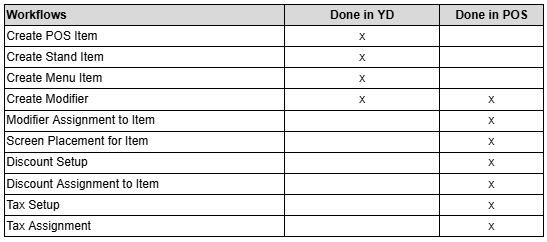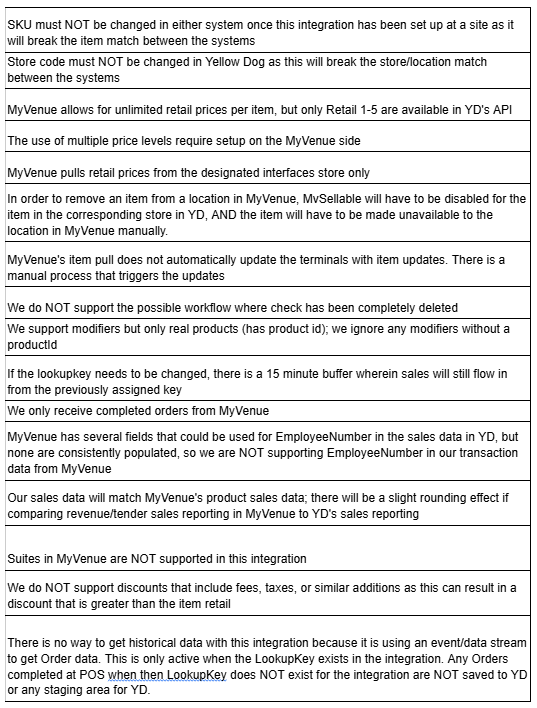MyVenue – 2 Way Interface
Note: This integration is provided on a conditional basis.
Overview
In this two-way interface with MyVenue, Yellow Dog gets sales data from a data stream, and MyVenue pulls item data from Yellow Dog’s Fetch API.
Sync Approach
This two-way integration involves three main elements:
YD’s MyVenueConsole, which
relies on a data stream from MyVenue to S3 from which it pulls sales data
pulls locations and items (for POS Item Mapping) from MyVenue’s API
YD’s ProcessSalesConsole to process sales
MyVenue’s process to pull item data from YD’s Fetch API
Sync Frequency :
Sales: As needed and depending on any other syncs running against the database, but usually every 30 minutes for stadium clients.
Items: Daily, but can also be run manually as needed.
NOTE: MyVenue's item pull does not automatically update the terminals with item updates. There is a manual process that triggers the updates.
Configuration
Multiple instances of MyVenue against a single instance of Yellow Dog is NOT supported for this two-way integration.
Multiple Locations per Yellow Dog Store is supported for sales only.
Requirements
Client
Ensure that any pre-existing Locations in MyVenue have location codes that match the appropriate Store codes in YD
Ensure that any pre-existing Items in MyVenue have skus that match the appropriate item skus in YD
Prep items that should be pulled from YD into MyVenue
Revenue Center Mappings (for MyVenueConsole)
Yellow Dog:
Create an API User and provide ClientID and login to MyVenue
POS:
Provide the following, needed for Yellow Dog’s MyVenueConsole to pull Sales and Locations for sales mapping:
siteId = TenantId/VenueId in thirdparty system
clientId = api userNameOrEmailAddress in thirdparty system
clientSecret = api password in thirdparty system
SQS queue has to be set up for the customer on MyVenue side
POST MvSellable interface codes to YD's Fetch API
Configure and schedule their daily item pull process from YD's Fetch API
Data Exchange
Sales Data from POS
Overview (how, who does what, when)
Sales are sent from MyVenue via a stream that updates to a customer-specific s3 folder. From there, YD’s MyVenueConsole pulls sales from s3 into the YD database, and ProcessSalesConsole finalizes the sales data processing.
NOTE: There is no way to get historical data with this integration because it is using an event/data stream to get Order data. This is only active when the LookupKey exists in the integration. Any Orders completed at POS when then LookupKey does NOT exist for the integration are NOT saved to YD or any staging area for YD.
For the Sales pull,
YD pulls MyVenue Locations into the Yellow Dog database to be mapped to Yellow Dog Stores via our Balto web application
Matches sales data on YD’s SKU to MyVenue’s Product Code
We pull in the following sales data:
Modifiers are supported in this integration, but only when they have a productId in MyVenue.
Item Data from Yellow Dog
Overview (how, who does what)
MyVenue pulls items once a day from Yellow Dog’s Fetch API, but also allows for users to run their sync manually, as needed.
NOTE: Client will need to manually trigger item updates to terminals from MyVenue.
They match the MyVenue Location Code to the YD Store Code.
Interface Codes – MyVenue posts a single interface to Yellow Dog: MvSellable. When true for an item, MyVenue will pull in the item and, if the sku doesn’t already exist in MyVenue, create a new item; if the sku already exists in MyVenue, they will update the existing item.
SKU & UPC Limitations - SKU is added to the barcodes list in MyVenue to ensure that it can be scannable.
Yellow Dog Item to POS Mapping - Our MyVenue integration matches items on SKU: MyVenue ProductCode to YD SKU
Workflows - Where Performed:
Accounting Export Ability
This integration supports total net sales data only.












